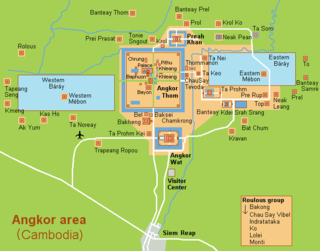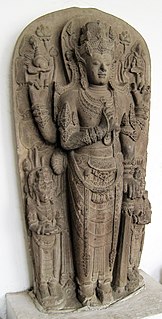
Angkor, also known as Yasodharapura, was the capital city of the Khmer Empire. The city and empire flourished from approximately the 9th to the 15th centuries. The city houses the Angkor Wat, one of Cambodia's most popular tourist attractions.

The Khmer Empire, or the Angkorian Empire, are the terms that historians use to refer to Cambodia from the 9th to the 15th century, when the nation was a Hindu-Buddhist empire in Southeast Asia. The empire grew out of the former civilizations of Funan and Chenla, which at times ruled over and/or vassalised most of mainland Southeast Asia and parts of Southern China, stretching from the tip of the Indochinese Peninsula northward to the modern Yunnan province of China, and from Vietnam westward to Myanmar. At its peak, the Khmer Empire was larger than the Byzantine Empire, which existed around the same time.

Angkor Thom, alternatively Nokor Thom located in present-day Cambodia, was the last and most enduring capital city of the Khmer Empire. It was established in the late twelfth century by King Jayavarman VII. It covers an area of 9 km², within which are located several monuments from earlier eras as well as those established by Jayavarman and his successors. At the centre of the city is Jayavarman's state temple, the Bayon, with the other major sites clustered around the Victory Square immediately to the north. The site is one of the major tourist attractions of southeast Asia.

Phimeanakas or Vimeanakas at Angkor, Cambodia, is a Hindu temple in the Khleang style, built at the end of the 10th century, during the reign of Rajendravarman, then completed by Suryavarman I in the shape of a three tier pyramid as a Hindu temple. On top of the pyramid there was a tower, while on the edge of top platform there are galleries. Phimeanakas is located inside the walled enclosure of the Royal Palace of Angkor Thom north of Baphuon.

Neak Pean at Angkor, Cambodia is an artificial island with a Buddhist temple on a circular island in Jayatataka Baray, which was associated with Preah Khan temple, built during the reign of King Jayavarman VII. It is the "Mebon" of the Preah Khan baray.

Jayavarman VII, posthumous name of Mahaparamasaugata, was king of the Khmer Empire. He was the son of King Dharanindravarman II and Queen Sri Jayarajacudamani. He was the first king devoted to Buddhism, as only one prior Khmer king was a Buddhist. He then built the Bayon as a monument to Buddhism. Jayavarman VII is generally considered the most powerful of the Khmer monarchs by historians. His government built many projects including hospitals, highways, rest houses and temples. With Buddhism as his motivation, King Jayavarman VII is credited with introducing a welfare state that served the physical and spiritual needs of the Khmer people.
Dharanindravarman II was king of the Khmer Empire from 1150 to 1160.
Jayavarman VIII, posthumous name Paramesvarapada, was one of the prominent kings of the Khmer empire. His rule lasted from 1243 till 1295, when he abdicated. One of his wives was Queen Chakravartirajadevi. He reverted to Hinduism from his father's religion of Buddhism and attempted to destroy Buddhism while patronized Hinduism throughout his regime.
Jayavarman I is considered to be the last ruler of the united Chenla, the predecessor polity of the Khmer Empire.
Jayavarman II was a Khmer prince who founded and became the ruler of the Khmer Empire after unifying the Khmer civilization. The Khmer Empire was the dominant civilization in mainland Southeast Asia from the 9th century until the mid-15th century. Jayavarman II was a powerful Khmer king who declared independence from a polity inscriptions named "Java". Jayavarman II founded many capitals such as Mahendraparvata, Indrapura, Amarendrapura, and Hariharalaya. Before Jayavarman II came to power, there was much fighting among local overlords who ruled different parts of Cambodia. No inscriptions by Jayavarman II have been found. Future kings of the Khmer Empire described him as a warrior and the most powerful king from that time frame that they could recall. Historians formerly dated his reign as running from 802 AD to 835 AD.
Jayavarman V was a ruler of the Khmer Empire from his state temple, Jayendranagari, at Jayendrapura. During his reign, the Khmer Empire had 20 cities or pura.
Theravada Buddhism is the state religion of Cambodia, which has been present since at least the 5th century.
Jeyavarman IV was an Angkorian king who ruled from 928 to 941 CE. Many early historians thought that he was a usurper. However, recent evidence shows that he had a legitimate claim to the throne. During his reign, the nation had 12 cities or pura.
Geoff Ryman is a writer of science fiction, fantasy and "slipstream" fiction. Ryman has written and published seven novels, including an early example of a hypertext novel, 253, or Tube Theatre. He has won multiple awards, including the World Fantasy Award.
Harshavarman III was a king of Khmer who ruled from 1066 to about 1080 AD. He succeeded his elder brother Udayadityavarman II and his capital was the so-called Second Yasodharapura, which had its center in Baphuon, built by his brother, and West Baray as its principal bàrày. He was married to queen Kambujarajalakshmi.

"Devarāja" was the religious order of the "god-king," or deified monarch in medieval Southeast Asia. The devarāja order grew out of both Hinduism and separate local traditions depending on the area. It taught that the king was a divine universal ruler, a manifestation of Bhagawan. The concept viewed the monarch to possess transcendental quality, the king as the living god on earth. The concept is closely related to the Bharati concept of Chakravartin. In politics, it is viewed as the divine justification of a king's rule. The concept was institutionalized and gained its elaborate manifestations in ancient Java and Cambodia, where monuments such as Prambanan and Angkor Wat were erected to celebrate the king's divine rule on earth.
Vidyanandana, Shri Suryavarmadeva, or Suryavarman, was a Cham prince in Cambodia, who in 1182 put down a revolt that broke out at Malyang against Jayavarman VII. He arrived in Jayavarman VII's court in 1182 from Tumpraukvijaya, and was educated as a prince "in all branches of knowledge and all weapons". In 1190 he took part in the war against Champa and seized the capital Vijaya, capturing King Jaya Indravarman IV. Adopting the title of Shri Suryavarmadeva, he made himself king of Panduranga. He made Prince In, a brother-in-law of Jayavarman VII, "King Suryajayavarmadeva in the Nagara of Vijaya".
Jayavarman IX, also known as Jayavarmadiparamesvara was sovereign of the Khmer Empire from 1327 to 1336.
Kulaprabhavati (6th-century), was a queen regnant of Funan in Cambodia in 514–517.
Jyestha or Jyeṣṭhāryā (9th-century), was a queen regnant of Sambhupura Chenla in Cambodia.







